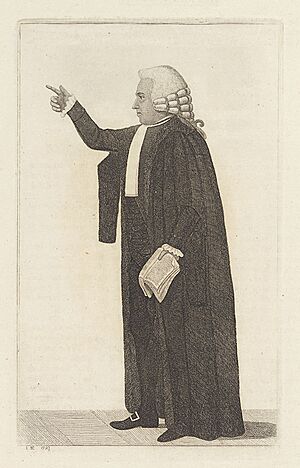Robert Blair, Lord Avontoun facts for kids
Robert Blair of Avontoun (1741–1811) was an important Scottish lawyer and judge. He held several high positions during his career. He was the Solicitor General for Scotland from 1789 to 1806. He also led the group of top lawyers as Dean of the Faculty of Advocates from 1801 to 1808. Later, he became the most senior judge in Scotland, serving as Lord President of the Court of Session from 1808 until he passed away.
Contents
Robert Blair's Early Life
Robert Blair was born in 1741 in Athelstaneford, Scotland. His father, also named Robert Blair, was a famous poet and a minister. His mother was Isabella Law.
Young Robert started school at Haddington. There, he became good friends with Henry Dundas, 1st Viscount Melville. This friendship lasted their whole lives. After Haddington, he went to the Royal High School, Edinburgh and then to the University of Edinburgh.
Becoming a Lawyer and Judge
In 1764, Robert Blair became a member of the Faculty of Advocates. This is a group of highly trained lawyers in Scotland. He quickly became a successful lawyer. He often argued cases against another famous lawyer, Henry Erskine.
In 1789, his friend Henry Dundas appointed him as a "depute advocate." This meant he helped with legal cases for the government. He held this job until 1806. For some years, he also worked as a legal advisor for the city of Edinburgh.
In November 1783, Robert Blair helped start the Royal Society of Edinburgh. This is a famous group that promotes science and learning.
High Legal Positions
In 1789, when he was 47, Robert Blair became the Solicitor General for Scotland. This is a very important legal role, helping the government with legal matters. He kept this job until 1806. During this time, he was offered a position as a judge twice, but he said no. He also turned down the job of Lord Advocate in 1802 and 1805. The Lord Advocate is Scotland's chief legal officer.
In 1801, his fellow lawyers chose him to be the Dean of the Faculty of Advocates. This meant he was the leader of the lawyers' group. When his friends returned to power in the government in 1807, he again refused the jobs of Solicitor General and Lord Advocate. But in 1808, he accepted the top judge position: Lord President of the College of Justice. From then on, he was known as Lord President Blair.
His Death and Legacy
Robert Blair died suddenly on May 20, 1811. He passed away at his home in George Square, Edinburgh. He was buried nearby in Greyfriars Kirkyard. His grave is in a special part of the graveyard called the Covenanter's Prison.
Interestingly, his old friend, Henry Dundas, came to Edinburgh for Blair's funeral. But Dundas himself became ill and died on the very day Blair was buried. This unusual event led to a poem being written about both their deaths. This suggests Blair's funeral was on May 28, 1811.
Robert Blair's Family
Robert Blair married Isabella Cornelia Halkett. She was the youngest daughter of Colonel Charles Craigie Halkett. Robert Blair's wife, one son, and three daughters survived him. They did not have much money left, so the government gave a special payment to his wife and daughters.
One of his daughters married Alexander Maconochie, Lord Meadowbank. Their son was Professor Allan Alexander Maconochie.
What People Thought of Robert Blair
Robert Blair was known for being very smart and logical. He understood legal rules very well. However, he was not known for being a great speaker. People said he had a strong love for fairness and hated wrongdoing. He had a broad and modern view of the law. This made him very suitable for the important judge position he held, even though it was for a short time.
It's interesting that Blair never became a member of parliament. For fun, he enjoyed farming. He made his small farm at Avontoun, near Linlithgow, very productive.
Today, you can see a statue of him by a sculptor named Chantrey. It stands in the Court of Session building. Two portraits of him were also painted by Kay of Edinburgh in 1793 and 1799.
Images for kids





